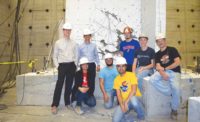The good news for Chileans is that less than 1% of the 10,000 buildings three stories or taller, constructed since Chile’s 1985 earthquake, will have to be demolished as a consequence of the magnitude-8.8 Maule earthquake that struck on Feb. 27. The bad news is that the type of structural damage observed in many of the bearing-wall concrete frames of 12- to 26-story buildings is calling into question the effectiveness of Chile’s building code, which does not require confinement reinforcing steel for concrete members. A code change in the future is likely, say engineers who inspected the damaged areas.
Of the 10,000 buildings three stories or taller built since 1985 in the area affected by the Maule quake, there were 2,000 buildings nine stories or taller. The total number of collapsed buildings is roughly five, says Rene Lagos, owner of the Santiago-based structural firm that bears his name. There are another estimated 50 buildings that will have to be demolished, he adds.
“In the U.S., in a maximum-considered earthquake, we talk about 10% of buildings being damaged beyond repair, not 1%,” says Jack Moehle, professor of structural engineering at the University of California, Berkeley, and the leader of the Earthquake Engineering Research Institute’s 30-member team that toured affected areas in Chile. “The buildings did really well,” he adds.
The trip, from March 10-20, was sponsored by the National Science Foundation. The multidisciplinary teams of four or five studied seismic performance of all types of engineered structures, building components and interior finishes, hospitals and the impact of the tsunami.
Most high-rise apartment buildings in Chile have bearing-wall concrete frames, rather than shear wall frames more common in the U.S. Still, many lessons can be learned from the Maule quake, says Moehle.
The Earthquake Engineering Research Institute now is waiting for drawings of a selection of Chile’s buildings and recordings of ground motions during the quake. The buildings then will be computer-modeled using the American Concrete Institute’s “ACI 318” code. The goal is to determine whether U.S. codes are too conservative or need to be ramped up. “This is a good testing ground for our building code,” says Moehle.
In Chile, the “Seismic Design Code NCh 433-1996,” which provides minimum requirements for life safety, is a translation of “ACI 318-95.” But there are some exceptions to the code. One allows the use of fewer confinement hoops, ties and hooks in walls.
Engineers are not required to confine walls because of the “satisfactory behavior of our buildings during previous quakes,” says Lagos, whose buildings did not suffer structural damage in the quake.
The more recent “Reinforced Concrete Structural Design Code (NCh 430-2008),” which is based on “ACI 318-05” with some exceptions, requires walls to be special structural walls. Frames must be special-moment-resisting frames, and the use of intermediate moment frames is allowed only if the structure has enough walls. The inconsistency between the two standards was solved in the “2010 Seismic Design Code,” approved in 2009 but still not official, according to Augusto Holmberg F., CEO of the Instituto del Cemento y del Hormigón de Chile, or the Chilean Cement and Concrete Institute. The new code adopts the criteria established in the new “RC Design Standard.”
Taller, More Slender
In the years since Chile’s 1985 quake, buildings have gotten taller, while walls have become more slender—wall thickness often having dropped to 15 cm from 30 cm, says Moehle. Architectural demands, especially on narrow lots, have resulted in basement parking. There, walls have been reduced in length from the walls above to create access ramps for vehicles in a configuration called flag walls (see drawing).
“This creates a stress concentration,” says Moehle. “Axial stresses are very high in some walls,” he adds.
In addition, quake ground motions were at or exceeded code levels for vibration periods between one and two seconds. “Put this together and many buildings were overloaded, with resulting compression failures,” says Moehle.
Shorter basement walls were crushed, and buildings listed somewhat. One 18-story building listed 22 cm at the roof; the confinement exception was followed in this case. “Many of the damaged buildings did not have confining steel,” he adds.
Not all Chilean engineers followed their code’s minimum requirements. Some followed the “ACI 318” provisions completely. Their buildings fared well in the quake, says Moehle.
Residents of the damaged buildings are afraid to re-inhabit them and want them demolished, says Moehle. However, contractors already are shoring them.
“This type of damage, in the majority of cases, is repairable and will be repaired, no matter how tall the building is,” says Lagos. “The problem is, who will pay for [the repairs],” he adds.
Moehle draws a lesson from the Chile experience for U.S. seismic engineers, saying tried-and-true code traditions should not be tampered with lightly. The engineer is concerned about the very big moment-resisting frames used more commonly in recent years by U.S. seismic engineers. A building’s seismic resistance is provided often by only one or two framing lines and a few bays. “Be careful,” he warns design engineers. “Don’t gain too much confidence in your techniques.”









Post a comment to this article
Report Abusive Comment